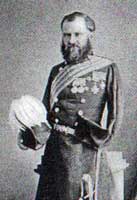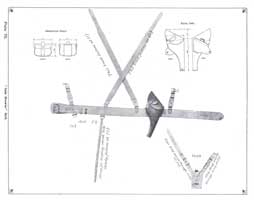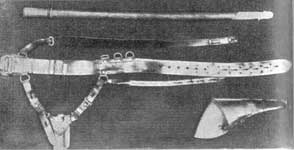DEVELOPMENT HISTORY
 By 1852, a young Indian Army officer, Samuel James Browne, had evolved a different design. It could be called the U.K.’s very first “Integrated System” of accoutrements as, once assembled, it was put on like a waistcoat. It beats by almost two decades, the first Integrated System designed for the Rank and File – Valise Equipment, incorrectly termed by writers as “Pattern 1871” (which it was not.). The prototype was probably made for him by the regimental saddler, using the metal fittings manufactured by the lorimers who supplied his trade. In 1856 Sam took his design to a saddler in London, who made up the “productionised” version. In this year, Sam still had two arms, a point to note. Sam would later record of this London saddler, “…He did credit to my invention, but soon all sorts of Patterns under my name were made and all sorts of bastard things were issued…”. The photograph at left, taken in 1870, shows Major General Samuel Browne, V.C., C.B., Commanding Peshawar District.
By 1852, a young Indian Army officer, Samuel James Browne, had evolved a different design. It could be called the U.K.’s very first “Integrated System” of accoutrements as, once assembled, it was put on like a waistcoat. It beats by almost two decades, the first Integrated System designed for the Rank and File – Valise Equipment, incorrectly termed by writers as “Pattern 1871” (which it was not.). The prototype was probably made for him by the regimental saddler, using the metal fittings manufactured by the lorimers who supplied his trade. In 1856 Sam took his design to a saddler in London, who made up the “productionised” version. In this year, Sam still had two arms, a point to note. Sam would later record of this London saddler, “…He did credit to my invention, but soon all sorts of Patterns under my name were made and all sorts of bastard things were issued…”. The photograph at left, taken in 1870, shows Major General Samuel Browne, V.C., C.B., Commanding Peshawar District.
During the Indian Mutiny, in 1858 Sam won the Victoria Cross, in an action that cost him his left arm, virtually severed at the shoulder by a mutineer’s tulwar. With no left arm, he was unable to Carry Swords, when walking and must have given some  thanks for his foresight in having invented – years before his loss- the belt that carries his name today. It is to be hoped that this information finally corrects the apocryphal story that every writer has trotted out, that Sam invented his belt as a result of losing his arm. You read it first in Karkee Web!!
thanks for his foresight in having invented – years before his loss- the belt that carries his name today. It is to be hoped that this information finally corrects the apocryphal story that every writer has trotted out, that Sam invented his belt as a result of losing his arm. You read it first in Karkee Web!!
His design quickly caught on with other officers in the Indian Army and use spread throughout the British Army, amongst all officers serving overseas. His belt was then officially recommended for universal issue - within the Indian Army - in 1882. Long after he retired, in 1898 Sam saw his design finally accepted for Home Service, in the U.K., though not before he’d had a few choice words to say on what the Army had made of it. The 1900 Dress Regulations illustrated the Sealed Pattern (right), with a composite photograph. The Lists of Changes had drawings of a very slightly different design. However, Sam’s design now included two Shoulder Braces and a Pistol Ammunition Pouch.
SAM’S OWN BELT
 It should be remembered that Sam had only devised a means of carrying a sword and pistol, together with the means of supporting the weight of a sword and a strap to prevent sway on the scabbard. This should be emphasized – it had only a single brace, supporting the sword frog. It did not include any other item, not even a pouch for pistol ammunition and it is important to keep this in mind, when faced with innumerable “add-ons”, all allegedly enjoying “Sam Browne Equipment” status.
It should be remembered that Sam had only devised a means of carrying a sword and pistol, together with the means of supporting the weight of a sword and a strap to prevent sway on the scabbard. This should be emphasized – it had only a single brace, supporting the sword frog. It did not include any other item, not even a pouch for pistol ammunition and it is important to keep this in mind, when faced with innumerable “add-ons”, all allegedly enjoying “Sam Browne Equipment” status.
Until Independence, in 1947, the original belt was on display in the Officer’s Mess of the Sam Browne’s Cavalry (12th Frontier Force), originally 22nd (Sam Browne’s Own) Cavalry, Frontier Force (shown above left).Today it is on display in the National Army Museum, in London. Sadly, it is not quite as complete as it was in 1940. Rather setting the standard, it has distinct differences from the later “Sealed Pattern”, just as vast numbers of subsequent copies would differ! The belt was unofficial for almost half a century, so when other officers noted the design and paid for their own examples, there was no requirement to exactly copy Sam’s design.
The belt is very plain, with none of the decorative stitching of today’s belts. The rivets are of a five-petalled floral design. The additional two dees, to the right of the original, were added by Sam, solely to cope with wearing the belt over a sheepskin coat, or poshteen. The shape of the holster is not Sam’s design, as it existed earlier. The design changes he made lie on the reverse of the holster. A visual comparison, by the reader, between the 1940 photo and the 1900 LoC, allows this introduction to be a précis. If further detail is required, please don’t hesitate to ask KWRT to add more detail.
STORY OF SAM BROWNE EQUIPMENT
Older “Sam Browne” belts, made before the pattern was sealed, continued in use. Newer ones did conform - after a fashion, but variations were still made. The sheer number of leatherworkers, across the British Empire, guaranteed variation, as would the supply and availability of metal fittings. In addition, since he was paying, the officer would often specify to his own taste. In consequence the varieties of “Sam Browne” are almost infinite in number. Any attempt to be definitive, beyond the loose adherence to a common theme, is bound to fail. Despite Sealed Patterns today, older belts have been handed down the military generations and are being worn today.
An officer’s “private purchases” also had to include a revolver. Eventually, this was regulated to require only those using 0.455-in. ammunition. The different frames and barrel lengths led to many differently shaped Cases, pistol. To this were added every kind of variation in the brass fittings, which from 1898 were supposed to have been the same. Though the Pouch, ammunition, pistol remained substantially the same, there were variations, just as there were with the Frog, belt, waist and even the Belt, shoulder, sword. The greatest variation is seen on the Belt, waist, sword, where the brass loops fitted range from greater than eight, right down to none.
© R.J. Dennis February 2009